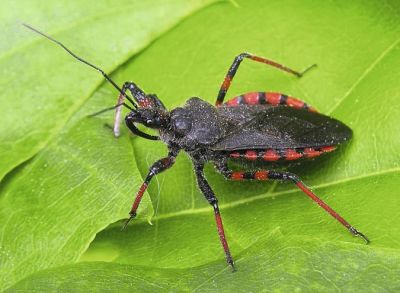Content
Predatory bugs are a family belonging to the order Hemiptera, and they are considered one of the most dangerous representatives of this order. Among them we can distinguish individuals that feed exclusively on insects and their larvae, as well as those that need fresh blood from humans and other warm-blooded animals. These varied feeding preferences indicate their unique position somewhere between predators and parasites.
Predatory bugs live almost everywhere, spreading to different parts of the world. They live both in Europe, Africa, North and South America, and in the post-Soviet space, where there are many species of these bugs.
Brief information about predatory bugs
In Latin: Platymeris biguttatus
Systematic position: Arthropods > Insects > Hemiptera > Predators
Habitat: Lives in southwest Africa in countries including Benin, Gambia, Guinea, Democratic Republic of the Congo, Zambia, Zimbabwe, Kenya, Ivory Coast, Mali, Mozambique, Niger, Nigeria, Senegal, Somalia, Sudan, Tanzania, Togo , Uganda, the Republic of Chad and Ethiopia.
Catering: This is a predatory insect that feeds on various insects of suitable size, such as cockroaches, beetles, crickets, flies, etc.
Lifespan: Larvae develop within 6–9 weeks from hatching to adulthood; adult bedbugs live approximately 1,5–2 years.
Interesting Facts: These bugs reach sizes up to 40 mm and live in tropical rainforests. Their activity is mainly nocturnal. They hunt from ambush or patrol the territory. Their other name, "two-spotted killer bug," refers to the two white spots on the black wing covers, as well as their predatory lifestyle and strong toxicity. When biting, the bug injects a liquid containing acid and proteolytic enzymes into the victim, which decomposes proteins, and then it sucks the “broth” from the insides of the victim. Attacking or attempting to grab this bug results in painful bites and localized ulcers. Despite its relative danger, the predator bug is popular among terrarium keepers due to its appearance and interesting habits.
Predators and their external signs: how to recognize a dangerous individual?
Predatory bugs are distinguished by their impressive size, often surpassing other types of bugs. Their color depends on their habitat and degree of danger. In the tropics, they can have bright and multi-colored colors, while their relatives from temperate zones tend to have a brownish-brown palette. When danger arises, predatory bugs change their color to blend in with their surroundings, often taking on gray or woody tones.
Characteristics of predatory bugs include relatively long hind limbs and generally slow locomotion. Some species may lack wings. Their head has an oblong shape, and their proboscis is awl-shaped, strong and durable. The upper jaws allow them to quickly pierce the protective coverings of potential victims, and the lower part, with the help of special bristles, sucks out blood.
How do predatory bugs reproduce and what kind of lifestyle do they lead?

These predatory bugs prefer to hunt at night, when they hide among the foliage or on plant stems, waiting for a long time for their prey. When the prey approaches, the predator instantly reacts, makes a sharp lunge and pierces the victim’s body with its sharp proboscis. Unfortunately, there is usually no survival for victims. A bug bite entails the injection of poison, which causes paralysis and liquefaction of tissues and organs in a matter of seconds. Then the bug makes another puncture and sucks up the contents of the victim.
The reproduction process of these predatory bugs occurs relatively quickly. One female lays about 20 eggs, from which bright pink larvae emerge two months later. Over time, their color becomes darker, and completely changes after the first molt. They become sexually mature only after six months, and some females can be distinguished by the absence of wings.
Symptoms of bites: what symptoms indicate a possible health threat?
For a long time, some believed that only bed bugs can harm humans, but this belief is wrong. Although most bedbugs rarely bite humans, some species pose a serious threat to life. An example of such bugs are triatomine bugs, which live mainly in South America, and they carry the dangerous Chagas disease.
A bug bite causes pain similar to a hornet bite: painful, swollen and itchy. Itching, swelling and allergic reactions are just a small part of the inconveniences it brings. While the first two symptoms usually subside within 2-3 days, the allergy can last for a week or even longer. The wound caused by a bite heals slowly, and the regeneration processes are accompanied by slight rotting.
Triatomine bug bites can have even more serious consequences. The skin around the eyes and lips is especially dangerous. Bites are characterized by increased pain, redness, shortness of breath, swelling, intense itching and even a rapid pulse. Sometimes this can cause angioedema and other severe allergic reactions. But the most serious consequence may be Chagas disease, for which there is still no effective treatment.
What to do if bitten by a predatory bug?
Bites from predatory bugs always cause pain, so it is important to know how to react correctly in such cases. First of all, it is strictly not recommended to scratch the bite site. Despite the severe itching, try not to touch the wound, as this may lead to a secondary infection. Also avoid rinsing the wound in local waterways or using herbs. Instead, you can apply ice or a cold bottle to the bite to reduce swelling and relieve pain.
If an allergic reaction occurs, you should take an antihistamine and consult a doctor. Be especially careful about the safety of your children, as their bodies may be more vulnerable to the poison. Take measures in advance to protect them from bites, and in case of any unpleasant consequences, immediately call an ambulance.